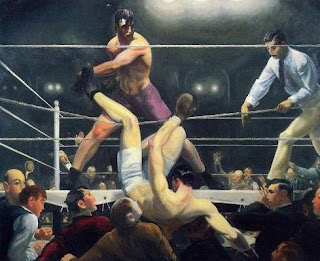 |
| George Bellows, Stag at Sharkey's, 1909 |
Hailed by the Metropolitan Museum installation of this
exhibition, George Bellows was one of “America’s greatest artists when he died,
at the age of forty-two from a ruptured appendix.” While I wouldn’t know to
argue with the Metropolitan, when I read this very big claim, the first thought
that goes through my mind and no doubt that of many visitors to the current
exhibition at the Royal Academy must be: Edward Hopper. Bellows and Hopper were
contemporaries and apparently studied together under Robert Henri in New York. And
for my money, there’s no question as to who was the greater artist.
 |
| George Bellows, Pennsylvania Excavation, 1907 |
The exhibition at the Royal Academy is small compared to its
installation in New York and so it’s difficult to know whether or not Bellows
was more consistent than the examples represented here indicate. Or perhaps he
was on the way to greatness, but he never quite found his style due to his
premature death. The answers to such questions would be clearer if there was
more of Bellows’ work on display. My first disappointment was with the limited
size of the exhibition.
 |
| George Bellows, New York, 1911 |
That said, there are some lovely paintings interspersed
throughout the exhibition, particularly, those that show the marginal life of
New York City in Bellows’: the boxing paintings of Sharkey’s, a well-known
joint hosting illegal activity at the time. Also impressive were the paintings
that depicted empty spaces in New York such as the foundation hole in the
ground that would become Penn Station, the Pennsylvania
Excavation, 1907. What I loved about these New York paintings was their
depiction of something that did not exist, the space, the emptiness, the void of
a world still to come. New York of this period is always depicted as a marvel
of modernist invention: skyscrapers, elevated subways, icons such as the
Woolworth Building, and the teeming turn of the century streets. But Bellows
represents the emptiness of the ground before all of this is built. Even when
he shows views along the Hudson and the East Rivers, it’s not the buildings in
the background that capture his eye, it’s the light on the water, the
reflections, the space of the river.
In paintings such as Men
of the Docks, 1912, Bellows interest in light at various times of day, its
reflections, its refractions reminds me of Monet – he wants to capture the
light as it reflects on the water, the night lights as they illuminate the pit
that will become Penn Station. In these particular works, like those of the
French impressionists, but with a much looser brush and a more dense use of
paint, Bellows primary interest is in light, in color, in paint. He is less
interested in the daily life of New York City. And so in the images of New York
we see Bellows lean in towards being a significant modernist painter: an
interest in form, in colour, in paint, light, and the simultaneous departure
from a fixation on figuration. But this promise is never realized. As Bellows’ career
progresses he becomes concerned with subject matter, and seems to leave behind
the fascination with questions of aesthetics. Similarly, he stays squarely
within the frame of representation, of traditional narrative painting. He never
reaches into the uncertain territories of abstraction. When we remember that these
works were being painted at the exact same time as Picasso was breaking apart
the picture plane, and completely abstracting the human body, Bellows becomes less
interesting and more derivative.
 |
| George Bellows, Dempsey and Firpo, 1924 |
The other works that stand out in this exhibition are those
for which Bellows is celebrated: the boxing works. In Dempsey and Firpo, 1924, or Stag
at Sharkey’s, 1909, the boxers occupy the empty space at the centre of the
painting, illuminated as it is by color as light, in a reflection of the light
of the performance. Again, in these paintings Bellows shows great promise in
his fascination with light, with form, with paint. The entwined bodies are also
interesting because they create a movement across the canvas that again
gestures towards something original, but doesn’t seem to get fully realized in
the oeuvre as it is presented here.
This is work that is derivative all the way. It’s work that
lacks the uncertainty and the ambiguity that plagues and moves forward the development
of modern art. In addition, Bellows is not inventing anything new, nothing we
haven’t seen done earlier, usually in the late nineteenth century. Ultimately this
makes his work unsatisfying and not so impressive.

No comments:
Post a Comment